15th May, 2023: We awoke with a new beginning to our voyage following our near-end experience at Vyborg. The night before, I methodically planned what I was going to watch. So we decided to travel to Pushkin, where the famed Catherine Palace is located, and then return to St. Petersburg in time to view St. Isaac’s Cathedral and complete our day’s adventure at New Holland Island.
We walked in a different direction to the Fruzenskaya Metro Station. The metro stations in St. Petersburg differed from those in Moscow for one simple reason: doors guarded the entrance to the metro train itself. This is to prevent accidents or suicides, aside from the evident younger coaches employed here.








The first three pictures show the metro stations (Fruzenskaya and Moskovskaya), the next one shows the public bus to Pushkin and the last four pictures show the highway between St. Petersburg and Sosnovy Bor.
From there, we went to the Moskovskaya Metro Station. We wanted to be to Pushkin by 11:00 a.m., so we opted to take an electrobus. You should appreciate Yandex Maps’ comprehensive coverage of Russian transportation services. The road to Pushkin also leads to Pulkovo Airport. As we approached the entrance, the lovely landscape and meadows became visible. Let me tell you something: the concept of charging the consumer per ride is useful, especially for long-distance travel.
Mum sat in the front, and I took the last available seat. (Near the bus engine). We got off where Yandex Maps directed us to. There was an Egyptian-themed model near the roundabout. (The Egyptian gates). The bus drove to Oktyarbsky Bulvar, and we began walking towards the palace via the narrow lanes. We caught a glimpse of the memorial honoring V. V. Dokuchaev. I arrived at Dvortsovaya Ulitsa and continued walking for another 1.5 kilometers till I reached the entrance.
The palace is officially referred to as “Tsarskoye Selo”. As we proceeded further, we were followed by a big group of kids who were traveling quicker than us. I increased my speed to avoid forming a long line behind which I would have to stand. I dashed towards its entrance on Sadovaya Ulitsa. The signs leading to the “Palaces” were visible along our route. Turned left and proceeded through an arch that is part of the National Pushkin Museum. The gardens cost 500 rubles, while the museum (route 1) costs 1000 rubles. The foreigners were charged double the fee. Fortunately, I was charged the same as a Russian and was able to access the royal museum, whereas Mum only had a garden ticket. As soon as we walked in, a man playing the flute was standing there. It sounded pleasant.







I stepped through the palace-museum’s enormous doors. Followed the “Palace Tour” signs to the starting site, where tourists were required to wear brown moccasins over their footwear. The counter behind was providing free Russian audio instructions. I didn’t realize this at first, so as I walked in, my ears were blaring with Russian sounds. Oh, I had to return them, so I walked to the audio-guides section near the exit. I needed to deposit my passport and get an English audio guide. (Do not tell me how I got my passport. I didn’t initially bring it inside. I had two people fetch my passport for me as I was standing at the exit gate. (The identical mistake was made in the Hermitage.)
The ushers were kind. As they moved around the palace room by room, many Russian tour groups were led by a guide who explained the significance of each area. They were quite quick and concise, but the English one took almost 2 minutes to complete.
Catherine I commissioned the palace while St. Petersburg was being developed and extended. The architect Johann Braunstein oversaw the construction of this palace before it was enlarged. Further tsars wanted the palace to look as European as possible, therefore several rooms were renovated to their exacting standards in art, mosaics, and architecture.
I passed the great staircase that leads to the Great Hall. It looked fantastic and is undoubtedly a jewel in Russian history. As I made my way to the antechambers, I was struck by their splendor, as explained by the audio guides. The paintings in each room, like those in other Russian palaces, were dedicated to Napoleonic wars, Tsars, Mother Russia, and Biblical events. Each room’s wooden flooring featured a unique pattern. The main hall featured a picture of Mother Russia as a uniting hand between Europe and Asia.










The Great Hall was decorated with paintings, windows, and gilded stucco. Greek and Roman reliefs were found throughout the panels. The interiors appeared to be Baroque in style, with Neo-Classical architectural characteristics. There was a couple standing there, the woman wearing traditional Russian garb. Anyone seeking to shoot with her must pay the man. Unfortunately, this was a means to make money in Russia, a new sort of beggary.
There were two routes for exploring the museum, and I was on route 1. I strolled by the dining rooms, and the Chevalier’s dining room was particularly impressive. The fruits, arranged cone-like, added an ancient yet innovative touch to the dinner table’s design. The pilaster rooms were red and green, respectively. There were the Empress’s favorite pastimes preserved as a showpiece. There were paintings of the Tsarina and her daughters.
The amber room is a must-see room. It was, in my opinion, the most breathtaking sight I seen in this country. Each amber piece was glued together like a jigsaw puzzle, resulting in the most costly room in Europe. My words cannot adequately depict this room. That is why you should come here. Next came the Portrait Room. A collection of paintings.
Along our route, I saw several more rooms, including the Waiter’s Room, the Chinese Blue Drawing Room, and the Pantry. Steps took me below to another room filled with historical paintings of this palace as well as events from the Leningrad siege in relation to it. Some of the furniture was fashioned of Lapis Lazuli, an Afghan gemstone. One intriguing aspect was the preservation of the palace’s valuable gems by moving them to central Russia. Despite this, Nazi forces looted a wide variety of objects. The reconstruction took several years. Another portrait depicts Vladimir Putin and officials at the reopening of the Catherine Palace Chapel in 2019.








Definitely the best.
My tour ended at 13:30 hours. Now it was time to explore the gardens. I bought a vegetable roll at a hut run by a man named Ararat. He is from Armenia and says he has been running it for two years. Pushkin is also famed for the Alexander Palace, but that is a topic for another time. We proceeded clockwise, beginning at Gribok, Teatr, Parnas, and finished at Prudky. Take a peek at the photographs.
Meanwhile, a Tinkoff worker named Pavel was assigned to me to provide the debit card. I messaged him in Russian to deliver the card at 21:00 hours. He backed out, and another representative, Elena, was selected. She promised to come to our apartment and deliver it after the visa was verified.










We took an electrobus from Pushkin to St. Petersburg and got out at the Moskovskaya metro station. It was time to eat lunch, and EUROSPAR, like always, came to our rescue. You now know what we ate. It was time to go to St. Isaac’s Cathedral, but it was already 17:00. Mum advised against seeing it right now because it will close in 30 minutes. Feeling rather sad over not being able to fulfill our day’s schedule, I went for a walk from Alexandrovskiy Sad, unsure where to go next. Mum waited in the garden. My desire to cycle or ride an e-scooter was increasing. I walked to the opposite end of the garden and saw the famous “Bronze Horseman” statue. I crossed Dvortsovy Most (the Palace Bridge, which is pulled up at night, making foot passage impossible), and decided to go to New Holland Island via Universitetskaya Naberezhnaya and Truda Street. Some areas of Universitetskaya Naberezhnaya received road construction. (I first missed the island’s entrance; the maps forced me to continue down Truda Street before reaching another road-works project, requiring me to walk along Kryukova Canal Naberezhnaya. This island’s entrance is located by Admiraltsevskaya Canal in Naberezhnaya. Other ports of entry are closed.










It is a manmade island that resembles Amsterdam, Netherlands, hence the name New Holland Island. It included some naval buildings, a museum for displaying paintings (ZIPERGALIZ Digital Art Gallery and SHULZ), some cafes (Kuznya and Cococo Bistro), a gift shop, and a playground.








At 20:00, we returned to the apartment and purchased goods from the DIXIT supermarket. Elena called and said she was on her way to our apartment. Okay, so much for getting a Russian debit card. She only knew Russian. She basically instructed me to have my passport, visa, and migration card ready. And at 21:00 (still daylight), she arrived at our apartment. (The Tinkoff mobile application has a maps section that allows you to track your representative. She first missed the path to our flats, so I had to pick her up as she retraced her steps.
She checked my documents and submitted soft copies. She then tore open an envelope and instructed me to sign a note in Russian, which I translated into English using the Translate app. Finally, the anticipated prize: the card! Later, she took a photo of me holding the card. I struggled with my Russian, so I used my Translate app and asked her one question about withdrawing from non-Tinkoff ‘bankomats’. Will a commission be charged? She said that as long as I do not take more than 3,000 rubles, the commission will not apply. After that, she left.
Later, I received a feedback notification from the Tinkoff app. We went to bed about 23:30. The day went smoothly.
16th May, 2023: The 16th of May was a day of conflicting sentiments. I saw the opera at the Marinsky Theatre but did not have enough time to see the Grand Peterhof Palace. I’ve been considering visiting the palace when I return. This time, our schedule focused primarily on the Peterhof Gardens and Palace. The evening was free, so I used my newly issued Tinkoff card to reserve a ticket for an opera at Marinsky Theatre, and I needed to act quickly. Simply because, as with the Bolshoi, such tickets are in high demand within Russia. The quantity of available seats reduces per hour during the day. However, it is not as insane as at the Bolshoi.
The same routine before the day begins. We got the same goods (raincoats this time) and breakfast. Mum mentioned to me yesterday that she was planning to travel to Peterhof by hydrofoil, which would cruise along the Neva and the Gulf of Finland. The return will take place via electro-bus. (By the way, numerous hydrofoils bear the name ‘Neva’). So we rushed back to the same area where we had been the day before. Arrived at roughly 10:00 a.m. An African man working for a private hydrofoil company approached us and attempted to lead us astray in our quest for a ticket. We saw through his deception and swiftly ignored him. A few feet into the hydrofoil platform, the lady at the ticket office informed me that all economy class tickets for the 10:00 departure to Peterhof had already been booked. We didn’t want to spend 2,000 rubles merely to get there in first class. We returned disappointed. I took some time to find out if there were any other hydrofoils working there. One pleasant Russian man who knew English encouraged me to come to his hydrofoil platform, and he said it costs 2,000 rubles for two persons, including the return ticket. (That would rule out the option of returning by electric bus.) And it will depart at 11:00 a.m.






When Mum arrived to this one, the lady said it cost 2,500 rubles per user, for a total of 5,000 rubles (including the return). It was infuriating. Mum answered negatively, and we discovered that hydrofoil firms were taking advantage of the vacationers’ vulnerability. Okay, it was determined that we would take the electric bus to Peterhof. We boarded it at St. Isaac’s Cathedral. It was busy, so I got the backseat. (Around the engine…)
The weather turned for the worse, and there was a strong downpour. The bus took the route to the Avtovo neighborhood, where many passengers disembarked. The bus drove down Prospect Stachek. It took a right at the roundabout for Strelna and left St. Petersburg. Strelna, like every other Russian town, is a tranquil, peaceful place. We arrived at Peterhof about 12:00. We arrived at the ticket booth 15 minutes late since the Peterhof entrance was still being renovated. A stop at a cafe and a restroom break. We had an expresso that cost 200 rubles.










To be honest, I was dissatisfied with how Peterhof’s ticket-management system operated. Tickets to the gardens cost 2,000 rubles. When inquired about the ticket to the palace, the personnel had no information. Mum did not enter. The first step after entering the gardens is to enter the palace. Unfortunately, there were no suitable signs leading to the palace. I entered a building and spoke in broken Russian about the palace’s entrance. The female employee had no idea what I was asking for. When I asked the Russian tourists about it, they gave me the cold shoulder. What the heck!
A watchman, observing my dilemma, approached me and urged me to return to the same building at 14:00 hours to receive the tickets. Okay, I had about two hours to cover this large garden. This palace, often known as the “Russian Versailles” after the city of Versailles in France, was commissioned by Tsar Peter I and expanded following a journey to France. As a result, it was constructed in the Baroque style. The palace included the Great Palace, the Samson Fountain, and the Morskoy Canal, which led to the gulf. Remember that it is placed on a 200-metre cliff. As a result, there are two gardens: lower and upper. This forms a straight line that is surrounded by gardens and palace chateaus.
I decided to traverse the gardens from west to east and continued downwards to Marlinskaya Alley after reaching the Eva Fountain. The alley looked lovely. That is the Russian beauty! This alley connects me to Marlinskaya Prudy and Sectoralnnye Prudy (ponds). Dvorets Marli (a modest palace that is now a museum) sits between the two. The entrance fee to this museum is 500 rubles, which is clearly a different ticket. I walked to Bakhusa Sad. And returned to Marlinskaya Alley, but it was busy with people taking shots and selfies, so I turned down Morskaya Alley and walked to a small beach where the hydrofoils terminate. My walk led me across the lane, where I took a good look at the Monplasir Palace-Museum. This museum, like the other palaces in France, had symmetry and was beautifully planned, with its brick walls right beside the coast. The grounds were enclosed by these walls and looked stunning with the motion-sensor controlled mini-fountain. The route narrowed, and Primorskaya Alley brought me to the Labyrinth, an artistically planned garden resembling a French one with a fountain in the center. Clearly, the gardens are the major attraction. And it was 13:30. (I forgot the watchman’s advice.)
I reached the end of the lane, which is marked by a border wall that separates the Peterhof and Alexandria Gardens. The gravel trail continues uphill to the Alexandriyskoye Shosse. After a few meters, I reached the top of Cascade Chess Mountain and quickly arrived at the Rimskiye Fountains. There were tulip gardens along the route to the Triton Fountain. It was surrounded by the Bolshaya Oranzherya. I was in Nizhny Sad. When I returned to where I had started, it was 14:30. There was the Great Peterhof Palace and the Grand Cascade Museum’s Grottoes. They each had an own ticket to enter.




Suddenly, the watchman’s counsel flashed into my head, and I hurried to the building, only to find… huge lines. I chided myself for being so careless. I assumed the Vyborg episode made me more responsible, but it does not appear to have done so. (At least I did not write the itineraries on the back of the grocery bills.)
Since it was late, I decided to return and reconnect with my mother. One thing, my dear readers, I sincerely apologize for leaving her in the lurch while I go have fun. I told my mother how frustrated I was with the way the ticketing system worked here. In my opinion, they should offer an integrated ticket that includes both the main museums and the gardens. Going to each museum and paying separately is an unnecessary procedure that should be eliminated.
With a broken heart, I returned to St. Petersburg, but due to Yandex Maps, we took an initial detour that led us to Peterhof. What happened? We took an electrobus, expecting it to drop us off at the Avtovo Metro station. It moved into the city. That’s when we realized we had taken the incorrect bus. Mum became irritated by my decision, so we had to walk back the same route. The weather worsened and began to drizzle. We hadn’t had lunch and were hungry when we arrived in Peterhof. To get some calories, we went to the supermarket and bought yogurt and bread.
We eventually arrived in St. Petersburg by electric bus. And once again, I was sent to the back seat, near the engine. There was a man passenger seated beside me who made my trip uncomfortable. The way he sat and his motions were, to say the least, unsettling. He is not Russian.
At 15:30, we arrived at Kirovskiy Zavod Metro Station. The electro-bus comes to an end here. And we discovered an issue. We were running out of rubles and needed additional money. Fortunately for us, there was a VTB Bank nearby. I got to the first level, and the money exchange (obnotyy valuta) was in a corner. The dollars were instantly swapped for 10,000 rubles. I deposited 3,000 rubles into my Tinkoff.
It started raining, and Mum was seated at the bank’s entrance. We were free this evening, so I took advantage of the opportunity to reserve a ticket at Marinsky. At 19:00, I booked an opera ticket through Marinsky Theatres’ online page. The website referred to it as “Zoluskha”. I believed it was a Russian folktale. (Until later, I discovered that it was the famous Cinderella opera. Mum laughed so hard when she found out.)




We took the subway to Sennaya Ploschad. I hadn’t mentioned this market in the travels. It is a flea market. As you might assume, this market sold shoes, clothes, electronics, groceries, and toys at low prices. Not many Russians come here. Many Central Asian residents of St. Petersburg come here to buy food. When I approached the market, an Uzbek man at a clothing store shouted out to me, and I responded. There were several Turks selling electronic things on the market. As you approach the other end of the market, you will notice a large number of cherries, strawberries, and tomatoes (from Samarkand, Uzbekistan) for sale. In EUROSPAR, they were sold 50 times more. As a result, this market offers a low-cost option for shopping in St. Petersburg.
We ate our lunch at the EUROSPAR on Nevskiy Prospect, near Sennaya Ploschad. We walked to Alexandrovsky Sad and then got the bus to the Marinsky Theatre. It was 18:30 when we arrived at the entrance to the famous theatre. I entered the theatre with my online ticket. My seat was placed on the first-floor balcony.
And by the time I got to my seat, the theater was already half full. At 19:00, the opera began. It was written in Italian, and the Russian translations were shown to the audience on LED boards above. Obviously, none of these helped me, though I did pick up some hints from my reading of the Cyrillic. The musicians were in the basement while the conductor led them, and on stage, there was a cacophony of performers, the lead actress, and the backstage crew, all of whom worked well together to make the production go seamlessly. See the photos and video I shot. (However, taking photographs or recordings is strictly prohibited).





It was roughly 20:30 when the opera ended. I was content with the opera. Streamlined nicely. After drinking 200 rubles of apple juice at the Marinsky bar, I left the theatre. I encountered a difficulty. Mum sent me panicked messages saying she couldn’t find the theatre’s entrance. She had my phone, and the battery was at 1%. And she gave me photos of where she was. I recognized that area along the canal. Since there was some distance to travel, I decided to hire an e-scooter now that I had my Russian debit card. I turned it on, used the YandexGo app, and went to that spot. Initially, I struggled to balance the scooter because the footpath was uneven and there were roadworks in certain areas. As I continued, Mum called and a Russian man spoke to me on the phone. He was Alexander, and he told me to stay there until they arrived. And they did arrive. A man and his girlfriend. Mum apparently asked the man for instructions, and he obliged. He had ties to India because his father was stationed in New Delhi at one time. In English, he told me, “Don’t leave your Mum behind.”
That quote left me speechless. Mum then accused me of preferring the scooter over her when we returned to our flat. That has left me thinking, as many of you will question. “Why did you take your mother on this trip? “She is frail.”
May 17th, 2023: Today our plan was to go to the Hermitage, followed by which we go to the Peter and Paul Fortress in Saint Petersburg.
We awoke at 08:30 hours, hired a YandexGo taxi to the Hermitage, and arrived at 09:20 hours. The travel was flawless. I knew very little about the Hermitage’s true nature.
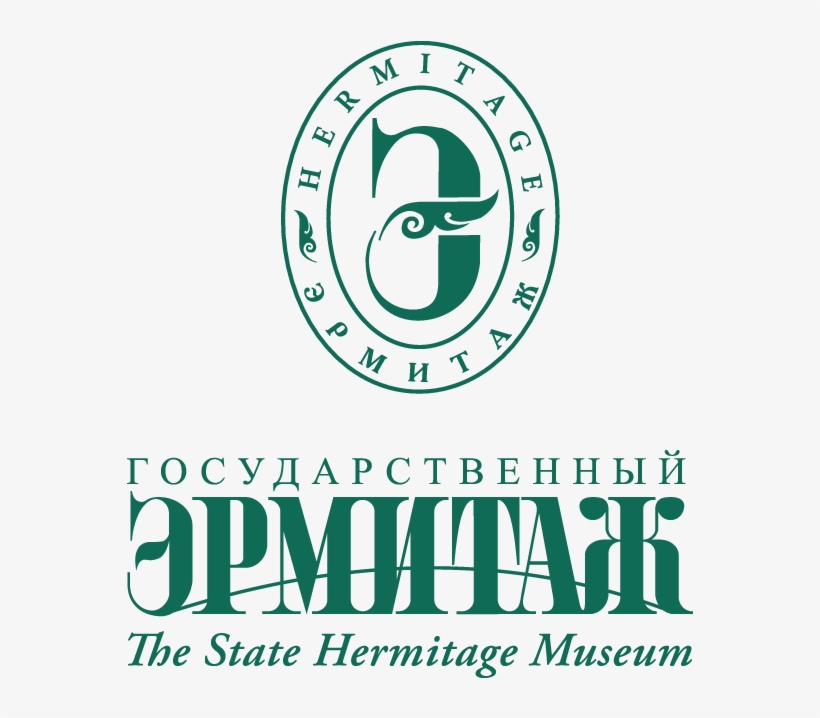
It is a complex that includes the Hermitage Theatre, the Small Hermitage (Malen Hermitage), the Large Hermitage (Novvy Hermitage), the famous Winter Palace (home of the Russian tsars), and the General Staff Building. The first five are open to the public and house an exhibition of paintings. The tsarina Catherine the Great acquired the initial set of paintings from a German trader, J. E. Gotzowsky, which served as the foundation for the museum’s current collection. It opened to the public in 1852. The name “Hermitage” comes from the word “hermit,” because in its early days, only a few members of royalty were permitted to visit. During the siege of Leningrad, huge collections were relocated to Ekaterinburg (central Russia), whence they were returned after the front lines of World War II shifted westward to Berlin. The Hermitage remains Russia’s golden gem to this day. It takes time to investigate because the collection is so large!
I could have purchased the tickets online, but I preferred to obtain a paper ticket. I stood in a short line behind a self-service ticket vending machine. The instructions for obtaining the ticket are self-explanatory. The language interface included options in Russian, English, and German. Cloakrooms, souvenir stores, audio guides, and guided excursions were all provided. (However, when I got there, it was only in Russian). The audio guides were offered in a variety of languages, including English, German, French, Chinese, and Korean. ATMs (Bankomats) and cafés are available. There is also the “Hermitage Hotel”.







The entryway was overcrowded. After a few steps, there was a large staircase leading up to the first floor. However, I turned right to visit the Egyptian and Mesopotamian Collections, as I am fascinated by Egyptology. I was shocked to see such a large collection of Egyptian and Mesopotamian ancient objects in this museum. Exploring both collections took roughly 45 minutes. After finishing the Ancient Near and Middle East portion, I ascended the stairway up to the first floor. (I failed to look at the Siberian and Caucasus sections.) This led me to the European painters section, which had separate sections for Italian, Spanish, Dutch, English, German, and French paintings. Paintings by Leonardo Da Vinci and Rembrandt (renowned Renaissance painters) were displayed behind a glass panel. The paintings centered on still life, Biblical themes, and royalties. The Winter Palace interiors are accessible via a short tunnel. Each room reflects the wealth and grandeur of the Tsars’ time in their previous home. Another portion is dedicated to Russian culture. Exploring these took two hours. And by the time I finished exploring these rare gems, it was nearly 14:00. Mum has already missed 10 calls. She was not interested in art or museums, so she waited outside.










Rooms 271 and 154 symbolize the Winter Palace’s Great and Small Churches, respectively, and they were spectacular. I got lost on the way to my port of entry after depositing my passport to get the audio-guide. After a half-hour of going to the third and ground floors, I found it. I haven’t been to the third floor, which is dedicated to Byzantium and Islamic cultures, as well as paintings. There is a separate section on “Iranian cultures”. Probably on my wishlist for next time.
If you visit the Hermitage, I recommend focusing on the portraits on each floor. Exploring the Hermitage thoroughly takes a day, so if you’re on a tight schedule like me, focus on these:
- Ancient World:
- Statue of Jupiter (Room 107, also nicknamed the Jupiter Hall)
- Room 109: Housing the Roman Gods. (nicknamed the Dionysius Room)
- Psykters and Amphoras (Room 111: Hall of Ancient Greece — central part of the hall)
- Sarcophagus with the Achilles Story (Room 115: Antiquities of the Northern Black Sea)
- Ancient Egypt: Focus on the sarcophagi and the Egyptian gods (they are present at the four corners)
- Hall of the Altai Tribes:
- A huge carpet of the Pazyryk Culture. (Room 26)
- Palace Interiors:
- Room 189 (Malachite Room): Cup on a Tripod shaped like winged female figurines.
- Room 197: (1812 War Gallery): Commemorating the defeat of Napoleon in the French-Russian War of 1812.
- Room 204: (Pavilion Hall): Housing the famous ‘Peacock Clock‘!
- Room 282: (Western European Silvers) — The items here are created in great exquisite taste!
- Room 306 (Boudoir): The room created for the wife of the Tsar Alexander II. It is studded with gilded stuccoworks and the scarlet tone of the room. In my opinion, this is the room I liked!
- Russian Culture:
- Empress Catherine II painting in Room 168.
- European Painters: (Whatever rooms I write here, see all the paintings.)
- English: Room No 298 – I found paintings that captivated me here.
- German: Room No 255.
- Italian: Room No 214 and 227.
- Spanish: Room No 254.
- Flanders: Room No 247.
When you visit Russia, remember to admire its history and culture first. Then concentrate on European painters, followed by Ancient Worlds and Egypt. The third floor is where you should end your visit. You will need to spend time on the second floor. If you just have an hour to spare, spend it in the Russian Culture and Palace Interiors.
I departed and rejoined my mother as we walked together across St. Petersburg’s Palace Square. The General Staff Building is designed like a bow. Before Moscow became Russia’s capital, it served as the location for government ministries. The eastern section is part of the Hermitage Museum. However, the western section is not open to the public. There were plans underway for a book festival. The palace square hosted historical events such as the Bloody Sunday in 1905. Auguste de Montferrand designed the Alexander Column, which can be found in the center of the square. As you pass over the Triumphal Arch, a walking path connects to the city’s major thoroughfare, Nevskiy Prospect.

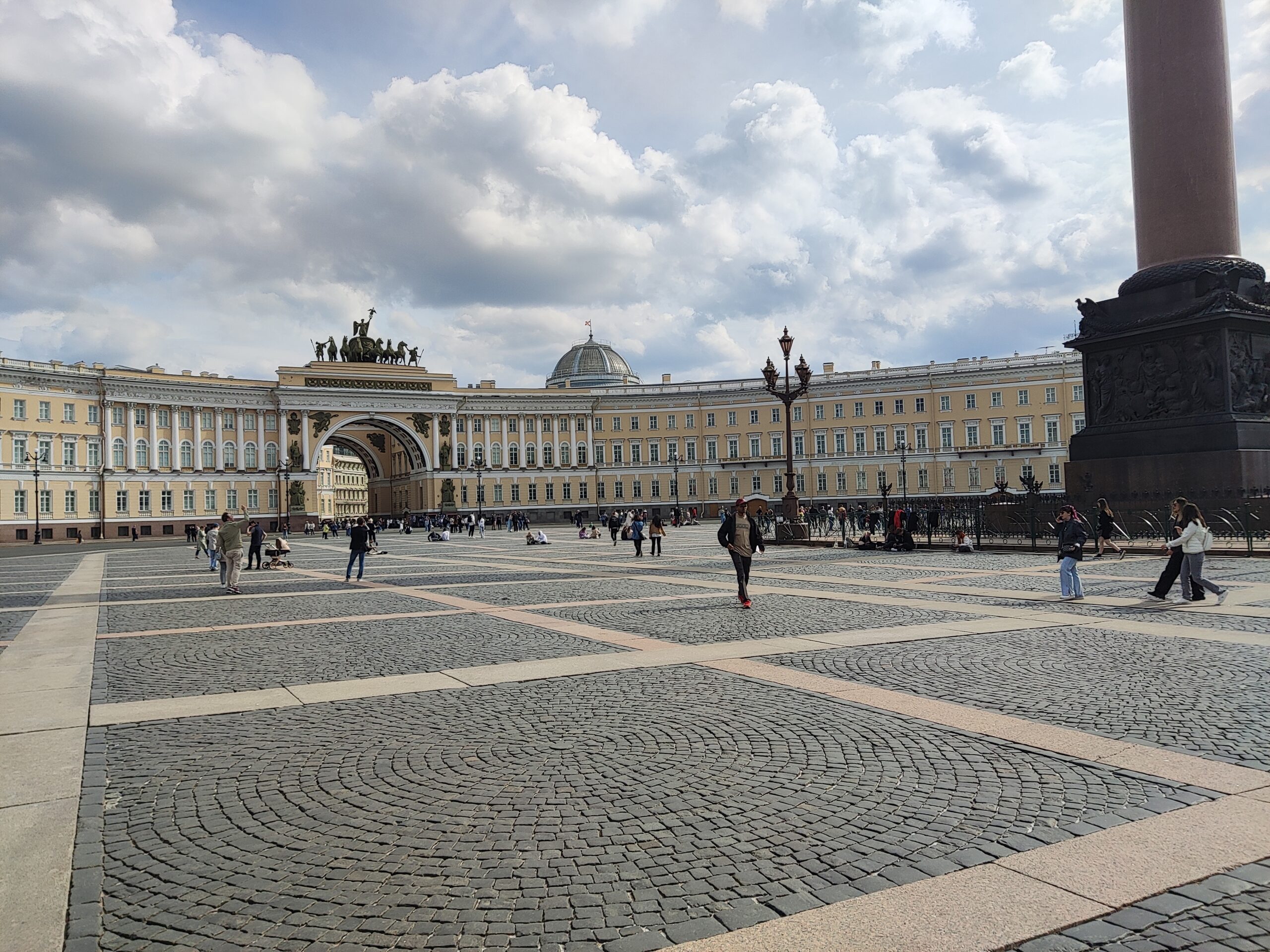
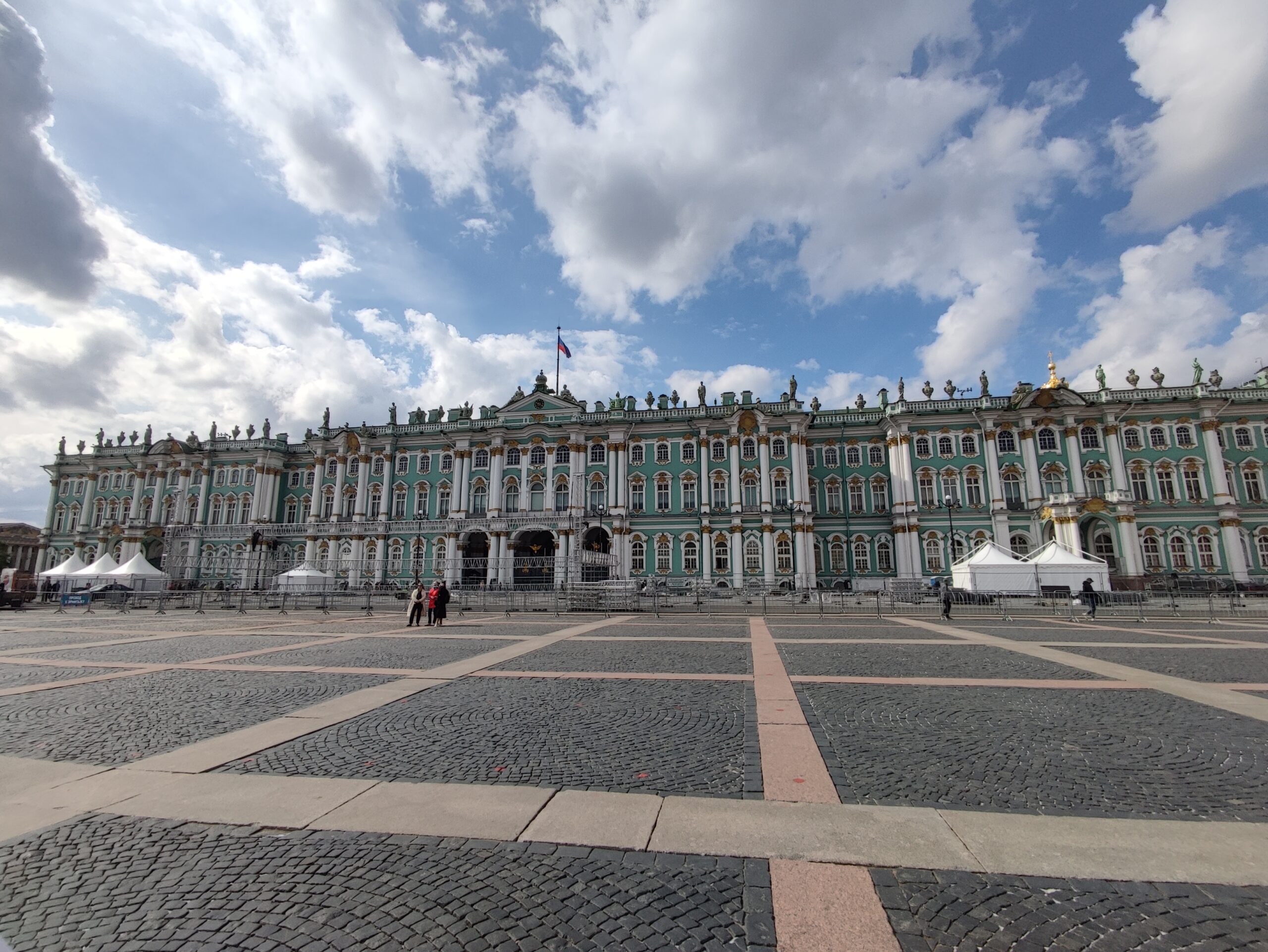
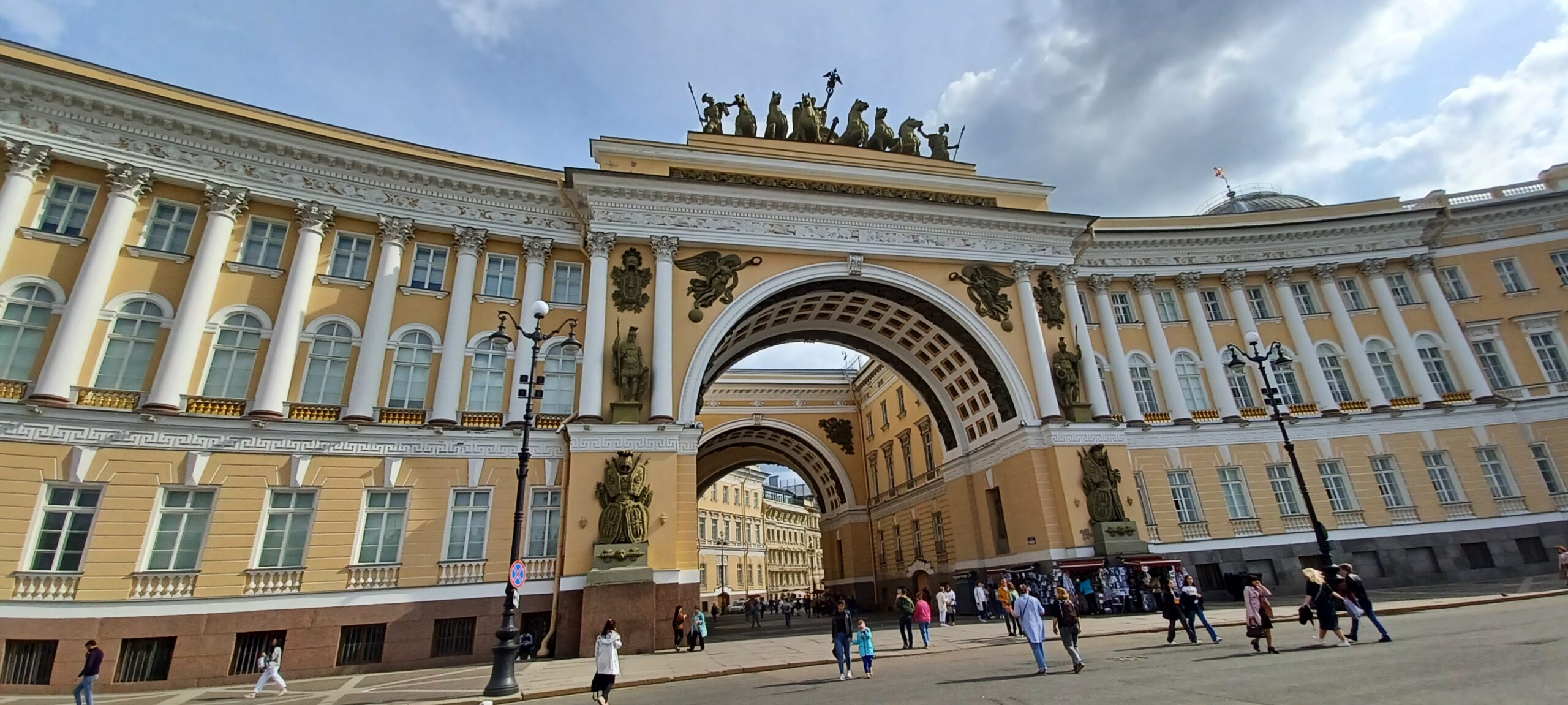
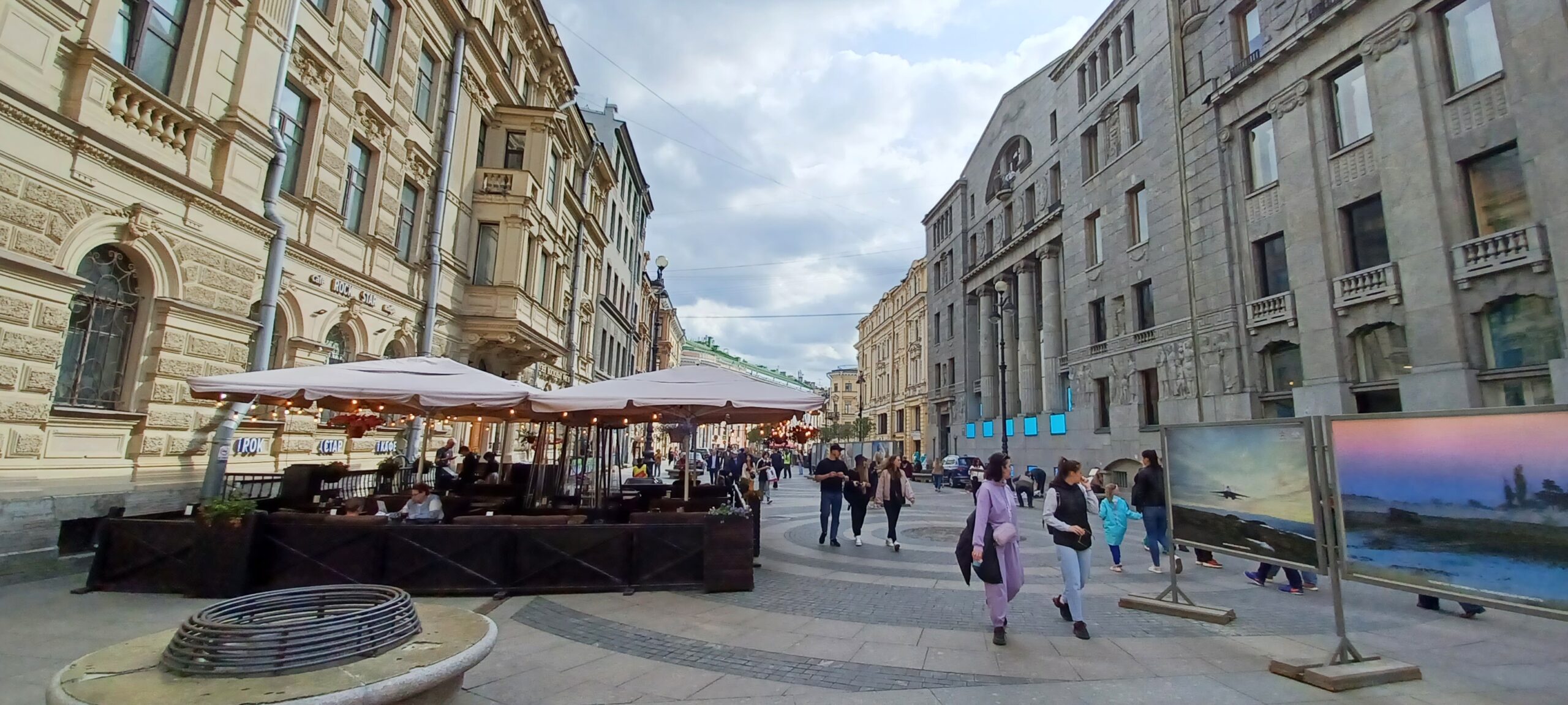
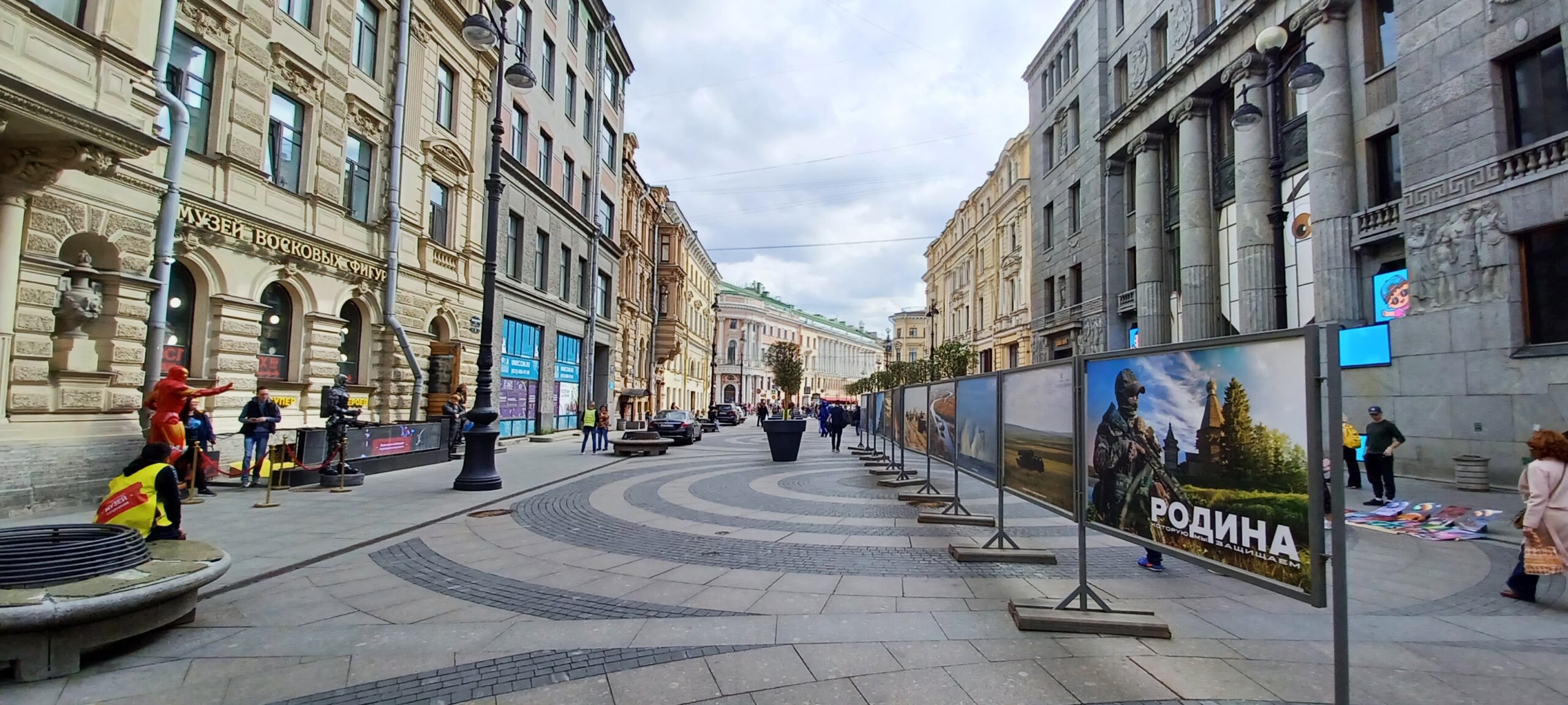
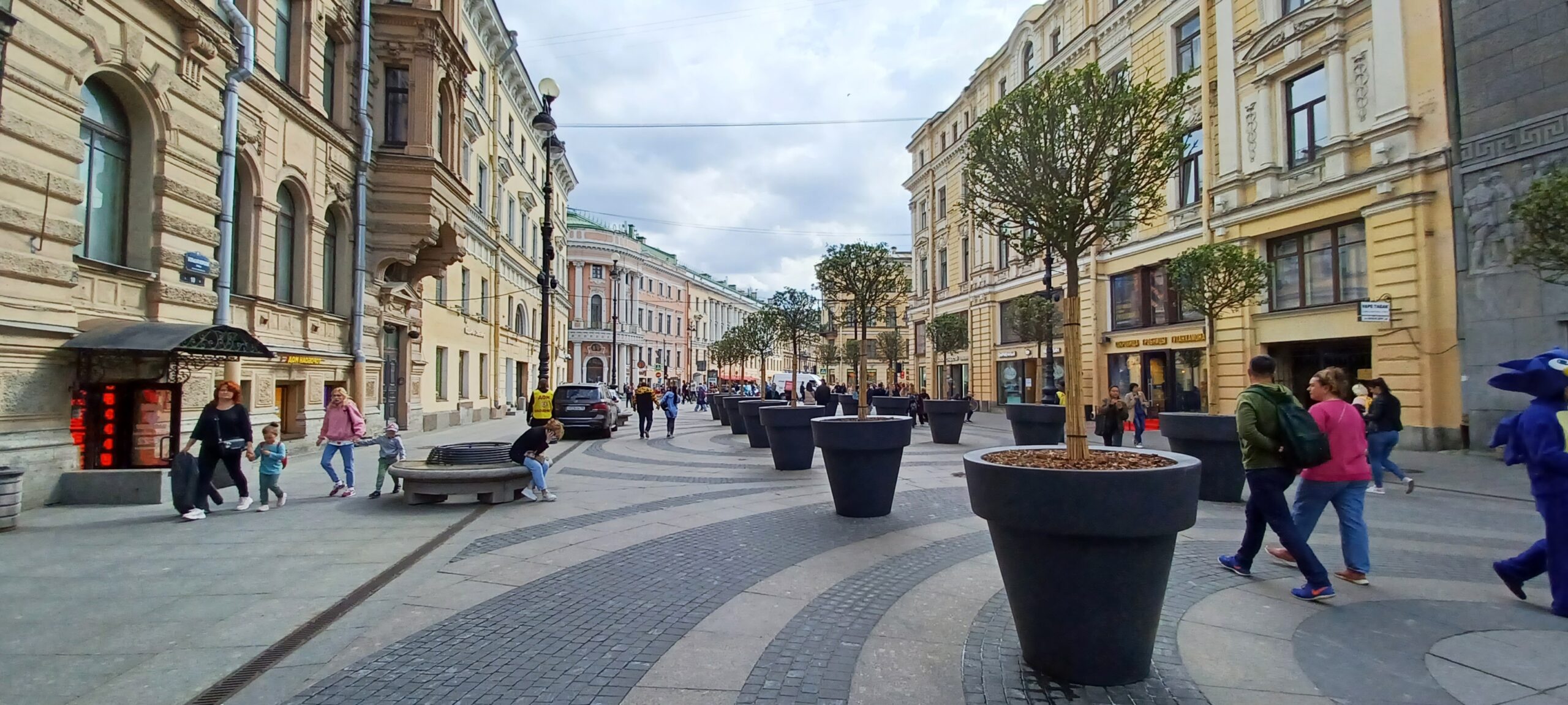
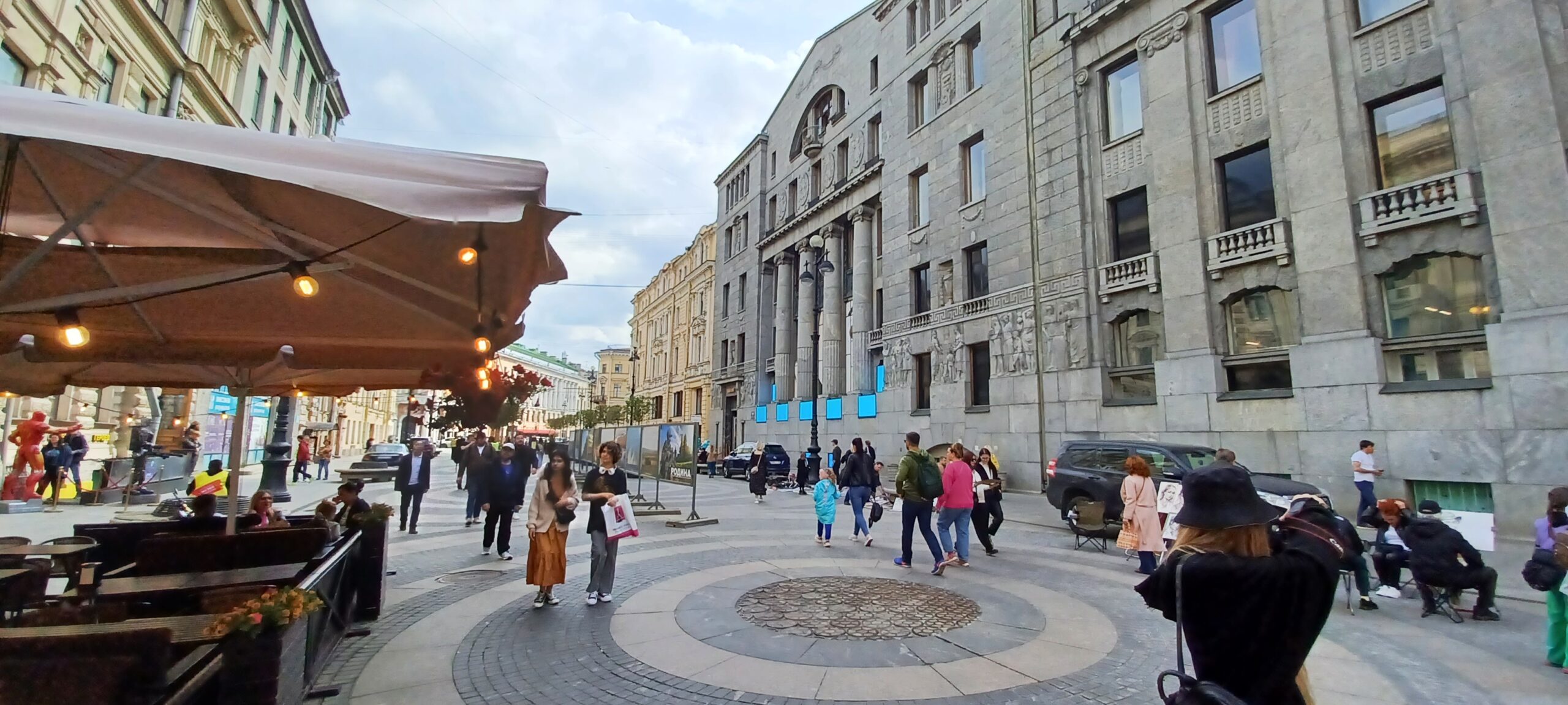
We ate lunch at a Russian restaurant at 15:50. Following that, we both walked to the Peter and Paul Fortress. It was around 1.5 kilometers. I returned to New Holland Island using the same route I had previously taken. The spit of Vasilevskiy Island appeared picturesque. After crossing another bridge (Birzhevoy Bridge), we continued along Kronverskaya Naberezhnaya till we reached the fortress entrance. Crossing the Kronverskiy Bridge, we arrive at the stronghold. My itinerary contained an element of poor preparation. The Peter and Paul Cathedral in the stronghold was closed. (It was Wednesday.)
The stronghold was built by Tsar Peter the Great and served as a garrison headquarters for the army. Not only that, but it housed the political prisoners of the time. It had a part in the Russian Revolution. Currently, it is a museum. The cathedral is the primary attraction. It looks beautiful and can be regarded the world’s tallest Orthodox Church, particularly the bell tower. It is synonymous with Saint Petersburg. Guess what? The fortress is seen in the backdrop of the 50 ruble note. At the top of the tower, an angel holds a cross. It houses the carillon, which was imported from Flanders (a Dutch-speaking region of Belgium). Except for Peter II, practically all emperors and empresses’ bodies are interred in the cathedral’s graves. The commandant’s cemetery adjoins the church. When we entered the fortress, an ensemble of lovely bells rang. Mum stayed behind as I wandered around the citadel, examining the streets. Alexander Nevskiy Cathedral and a few other museums were located here, but I chose to view the city panorama. After paying 200 rubles at a cash register, I went beyond an iron gate to enjoy the breathtaking views of Saint Petersburg.
There was a memorial plaque in the Panorama. There was a woman and her son playing there. He appeared to be fascinated in the city panorama, as I was, although he is young. His mother appeared to be engrossed in her phone. A wooden bridge connects to an observation platform. I took lots of photographs. The next stop in line was Trubetskoy Bastion, which held political prisoners. Although photography was not permitted inside, the prisons appear to be very gloomy!






I summoned Mum to come to the other side of the fortification and depart over the Ioannovsky Bridge. The stroll back to Alexandrovskiy Park, opposite the fortress, was lovely. The soul of Saint Petersburg was evident here. People from various walks of life are present. You could come across anyone playing a violin, a couple laughing, an artist sketching the stronghold on her canvas, an elderly man watching birds with his binoculars, or a man reading a book in the gardens. There is a Burger King just by the Naberezhnaya.
The primary attractions in Sad include the Museum of Artillery, the Zoo, and the Baltic House Theatre. We didn’t have time to get there, but maybe next time. We walked down a winding path to the Gorkovskaya Metro Station. There were university faculties all along Kronverskiy Prospect, as well as a mosque close.










I don’t need to tell you how the day ended. A lingering, persistent notion entered my mind: “Our trip to Russia is coming to an end…“

Leave a Reply